I baked SO MUCH BREAD this week! One of my classmates said that the week flew by for him. For me, it seemed to go on forever – not really in a bad way, though. I just kept having a feeling that I’d forgotten to do something that I had planned…for this weekend. And then I would realize that it was still the school week and the weekend hadn’t happened yet. We just did so much that it’s amazing to realize it was only the first week.
Broadly speaking, here’s the summary of what we did and what I learned:
We learned the basic function of (baguette) ingredients and environmental conditions, and we learned baker’s math; that means we can make and alter formulas on our own. Using formulas to bake bread basically means that you’re baking by ratios instead of by recipes. If you know how to use each ingredient in your formula, you can easily adjust for conditions you want to change. For example, if you find that a certain brand or type of flour makes your bread too elastic, you’ll have the problem (which we ran into) that, when you go to shape it into a baguette, you roll it out long…and then it springs right back into a shorter shape. Grr! Frustrating! Well, there are several ways to counteract this, one of which is increasing hydration – the amount of water in the formula. So, the next day that we used that flour, we added more water. This can be represented by the percentage of water indicated in your formula, and if you take good notes, you’ll know that whenever you use this flour (assuming all other conditions are the same), you’ll also need the greater percentage of water. (As it turns out, simply increasing the water wasn’t enough to really fix this dough, but I shan’t delve any further into that particular issue right now. If you’re interested, let me know in the comments, and I can review my notes and try to expand.)
We learned the procedures and techniques for mixing baguette dough in a large spiral mixer, proofing it (letting it rise), folding it (to increase strength – almost like a little tiny mini-kneading), pre-shaping it, shaping it, scoring it, and baking it. This includes using the big scary deck ovens I mentioned in my previous entry. They’re really not all that scary, as I suspected. They are a little cumbersome, though. There’s a big loading belt that requires some upper-body strength to operate; I’ll get better at that, I suppose.
We practiced making baguettes using three distinct formulas, for a “short mix,” an “intensive mix,” and an “improved mix.” These have slightly differing ratios of ingredients, and widely varying mix times and proof times. A short mix baguette is what you’d essentially be making if you made baguettes without a machine – relatively gentle mixing, for a relatively short amount of time, but long rise times. The baguettes come out smaller overall, but with a more open, airy interior. And more flavor! An intensive mix baguette is on the opposite end of the spectrum – you mix for a long time, and it proofs for a short amount of time. This is a stiffer dough that would be much harder to mix aggressively by hand; this technique became popular post-industrialization, when people invented machines that could do the hard work. This makes a large baguette, but the crumb is very tight, and the flavor is lacking. This technique is much better for a type of bread that is meant to have a tight crumb, such as challah or bread baked in loaf pans. These breads often have other ingredients lending flavor, too (like eggs or fat). Anyway, the improved mix is a happy medium between these two – a nicely sized, open-crumb, reasonably full-flavored baguette without too much time spent proofing.
We also learned how to shape batards, which are like shorter baguettes, somewhat football-shaped. We used essentially the same dough as we did for baguettes. Mostly, though, we did baguettes, and I’m glad – I need all the practice scoring them that I can get! Scoring is cutting the lines that run diagonally down the length of the baguette – they are pretty, but more importantly, they are functional. Bread rises one last time when it first enters the oven, and scoring the bread helps it do so evenly and fully. Scoring baguettes is particularly challenging; there are all these things you have to keep track of in order to score just right, and yet you’re supposed to do it quickly or your blade will drag. Anyway, our instructor has critiqued loaves each of us has made at the end of every day, and it is very clear that we’ve all improved a ton over just five days. Even still, many of us are talking about wanting to go in on Saturdays (we can do this, optionally) for extra practice. It’s cool to be part of a group that’s so eager to learn and do well!
Without further ado, here are some pictures.

Pre-shaped baguettes. These will rest briefly, and then be shaped into the final baguette shape before being scored and baked.
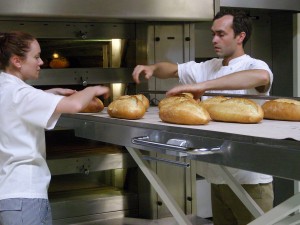
Checking batards to see if they’re ready (or maybe just checking to see if they’re ready for the next stage of baking, with the oven vented)
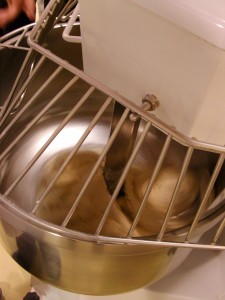
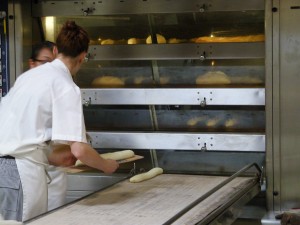

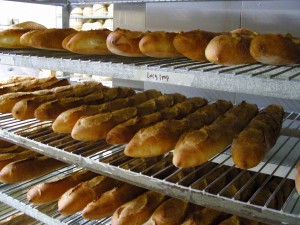
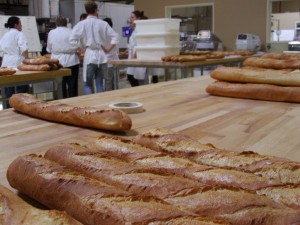
Wow! Some questions:
How do you keep track of whose bread is whose when it goes into and comes out of the oven?
Do you have to rotate the position of the bread in the oven or is there a mechanism that moves the shelves or ???
What is vented and un-vented baking? You refer to it, sort of, and I might guess, but it would be interesting to know. Is it important? Can it be done at home?
Are you slashing loaves in your dreams?!!!!
Keeping track of the bread is actually a little tricky — we’ve occasionally gotten it mixed up. We try to keep each person’s breads in the same row going into the oven, and then place them on the cooling racks in the same order (and label the racks). We do not usually have to rotate the bread. Of the two deck ovens, one seems to bake a little more unevenly, and the breads that are towards the front tend to be a little lighter, so they sometimes have to go back in after the others come out.
Venting simply means opening the oven up to airflow. There is a lever we press that I think opens something up inside the oven, and then we also open the glass door. Doing this at the end of the bake helps create a crispier crust, as it lets moisture out. We don’t do it for baguettes (not certain why, actually), but we do for larger loaves that are meant to have a crisp crust.
Not scoring loaves in my dreams yet, but that can’t be far off!